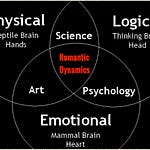The book, Introduction to Romantic Dynamics is now available on Audible, and I have three free access codes for you in either the UK or USA (whoever gets them first), as well as an audio podcast summary of the book above.
UK:
Redeem one of the FREE one-time use codes below before they are gone, at https://www.audible.co.uk/acx-promo
33EM3C8WHGJW3
2ZKLL5SXPQJBR
35KDWHDNBUCZD
USA:
Redeem one of the FREE one-time use codes below before they are gone, at https://www.audible.com/acx-promo
6C83ALMZ6X229
88ZBYH6SELA6P
8TXH866UYMDMT
Love in the Modern World
In a society increasingly jaded about love, the concept of love continues to hold significance between individuals, defying the cynicism that pervades modern relationships. Despite prevalent negative narratives, love retains its power to transcend gender biases and societal critiques. The paper explores the enduring nature of love, drawing from historical and literary references such as Miguel de Cervantes' portrayal in Don Quixote. By delving into the theme of love in contemporary times, the research sheds light on the timeless and universal aspects of human connection amidst a backdrop of skepticism and disillusionment.
An Introduction to Romantipedia
The section introduces the concept of Romantipedia, emphasizing the enduring possibility of finding love and peace despite societal cynicism. Here are the key points:
The core issue faced by the world today is the lack of understanding and empathy, with love being the solution to many social problems.
Despite the availability of love's healing power, individuals often choose not to utilize it due to personal pain or selfishness.
There is a prevalent sense of public scorn towards romance, leading to phrases like "Love is unfair" or "Love sucks."
Human biology is believed to inherently guide individuals towards finding love, defining the essence of human courtship which forms a major focus of Romantipedia.
Researchers like John Gottman, Helen Fisher, and Daniel Amen contribute statistical insights to understanding love, even though sociologists and advertisers can sometimes erroneously shape societal perceptions of love though polling and preferences instead of biological epiphenomena.
Romantipedia aims to integrate various human endeavors such as art, science, literature, music, and film to provide a holistic understanding of love.
The section reflects on the historical portrayal of love in art, literature, and music, highlighting the universality of love transcending time and culture.
While science offers valuable insights into relationships, there are limitations to purely relying on scientific findings, prompting a balance between scientific truths and enduring love stories.
Human courtship is presented as a hidden knowledge system blending science and storytelling, offering emotional and intellectual conclusions about love.
Romantipedia encourages a structured understanding of romance, correlating scientific research with different stages of a love story, aiming to depict love comprehensively and harmoniously.
ROMANTIC DYNAMICS
The section delves into using a combination of science, art, literature, music, and film to enhance our understanding of romantic relationships and maintain the magic of love discovery. Here's a breakdown of the key points:
Interdisciplinary Approach: Advocates for incorporating science with various forms of art to navigate the complexities of love and relationships.
Real vs. Ideal Love: Emphasizes the importance of learning about human courtship through these disciplines realistically, beyond idealistic or fantastical portrayals of love.
Challenges to Love: Acknowledges the plethora of modern obstacles such as career demands, financial instability, illness, and misleading information that obscure the path to love.
Individual Perspectives: Highlights the subjective nature of opinions on love mechanics, suggesting that personal views are shaped by individual experiences and may not universally apply.
Personal Growth: Suggests that understanding one's inner workings can lead to personal growth and potentially a better life, but indicates that replicating someone else's wisdom may not guarantee the same outcome without being that person.
Science
The section emphasizes the importance of using a scientific approach, rather than relying on opinions or advice, to understand love and relationships. It encourages readers to treat their own lives as stories with love as a central theme, using the principles outlined as guideposts to navigate their romantic journeys.
Key points included:
Experimental Approach: Readers are urged to go beyond just reading and to actively experiment by applying the concepts in real-life social settings, such as dates or clubs, to gain a deeper understanding of love.
Love as a Psychological Phenomenon: Love is described as a psychological concept, emphasizing that it is not easily visible or mapped out like a physical journey. Each individual's experience of love is unique and influenced by psychological factors.
Common Relationship Themes: Patterns in romantic relationships, like the loss of spark or commitment issues, are highlighted, indicating recurring themes in people's love stories.
Character and Personality: The section explores how personality, which is partly inherent and partly nurtured, plays a crucial role in relationships and how understanding one's temperament can impact their romantic experiences.
Personality, Character, and Instincts in Human Courtship
Personality and character, as distinct from instincts (gender and survival instincts), are central concepts in evolutionary psychology. Dr. Paul Mclean's model, a pioneering idea, forms the basis for understanding these differences.
Key points included:
Dr. Paul Mclean introduced the notion, distinguishing personality and character from instincts.
Evolutionary psychologists utilize this model to explore the possibility of three phases of romance in human courtship.
The distinction between personality, character, and instincts offers a unique perspective on love and courtship, bridging science and the arts.
This approach presents love as a "Three-act Play," integrating scientific and artistic interpretations of human relationships.
THE THREE BRAINS OF LOVE AND THE "BELL CURVE" IN US
The section delves into how love operates in humans, likening it to a three-act play structure, further exploring the concept of the "bell curve" within us.
Key points included:
Love is described through the lens of three brains, suggesting a multi-faceted approach to understanding this complex emotion.
The analogy of a three-act play structure is used to explain the dynamics of love, possibly reflecting different stages or intensities of romantic relationships.
The mention of the "bell curve" hints at a statistical distribution where love and its manifestations may vary among individuals, spanning from low to high intensity or experiences.
By framing love in this theatrical and statistical context, the section aims to provide a unique perspective on how love functions and varies within individuals.
1. Sexual Attraction (Desire)
In the reptilian brain, sexual attraction, commonly known as passion or desire, is intricately linked to the biologically masculine and feminine insincts seen in every culture around the world, even those with no communication with other cultures. It is likely also seen throughout all human history, when turning to the artifacts and records of cultures long gone. Some key points from this section include:
Desire, or Passion, is not an emotion, but rather an energetic, felt drive to spring into action, to communicate in certain ways, or to respond to others or to the environment, instinctually, which is to say automatically and unconsciously, without the need to think logically or creatively. It is the most energetic force in human interactions, and deeply rooted in the reptilian brain.
Passion is also synonymous with one’s felt sense of masculinity level if one is a biological male and also synonymous with one’s felt sense of femininity level if one is a biological female.
The masculine instincts have now started to be rediscovered by modern psychologists as inherent in every male, and they guide characteristic behaviors unique to the sex, when environmental forces either threaten life, the family, or the community (danger) or offer opportunity to pair-bond, which is to find romance.
The feminine instincts are inherent in every female, and guide behaviors unique to the sex, when environmental forces threaten life, the family, or the community, or offer the opportunity to pair-bond in romance.
These instincts formerly were called “archetypes” by Carl Jung, and known throughout mythology such as that of the ancient Greeks, who codified them into monolithic characters, gods and goddesses who typically represented singular, individual “powers” which were these distinct, masculine or feminine instincts.
Like the characters in Greek mythology, who sometimes worked together toward a goal like winning a war, the masculine instincts or feminine instincts may work together toward a social, career or personal goal.
A word most often used by males to signify a “master goal” of life, or “life’s goal” overarching all others for him, is “mission,” or “life’s mission.”
A word most often used by females to signify a “master goal” of life, or “life’s goal” overarching all others for her, is “purpose,” or “life’s purpose.”
When employed unconsciously and automatically in romance, the masculine and feminine instincts work together, amplifying each other when expressed in a normal, natural sequence called “sexual attraction,” or in modern terms, “early dating.”
In so doing, when right in time and circumstance, “imprinting” described by Conrad Lorenz occurs, one manifestation of which is “attachment,” and another, “bonding” for the new couple.
There are three steps each for men and women in the sequence of sexual attraction, the first phase of courtship, and when they are done right in timing and circumstance, the attachment and bond take hold, and the masculinity or femininity of the other (a.k.a. “passion”) rises in the both members of the new couple.
They are now ready to move on to emotional attraction (friendship), beginning with the emotional bond and sexual attachment now formed.
The insult, depletion or absence of the passions, masculinity or femininity is what we all call, “Shame.” It is the most direct and accurate definition.
2. Emotional Attraction (Love)
In the mammalian brain, emotional attraction, commonly known as love, or “friendship,” as in “boyfriend/girlfriend,” is intricately linked to personality traits and the two types of “self-esteem” we establish: “Well-being” and “Confidence.” Some key points from this section include:
Love, an emotion that plays a significant role in human interactions, is deeply rooted in the mammalian brain.
Emotional communication, a vital component of personality, influences how individuals form attachments and connections.
Understanding emotional attraction sheds light on how humans bond with others and navigate relationships based on affection and connection.
This section explores the neurological and psychological underpinnings of love, highlighting its importance in shaping social behaviors and intimate relationships.
Matching of personality, where each member of the couple brings to the table the cognitive and emotional (self-esteem type) the other lacks, makes for “best friendship” in the strongest kind of friendship bond of both emotion and the intellect.
“Best friends” obviously makes for the optimal state for two people to actually start considering a long-term relationship, because the matching of personality suggests the most durable bond that will also bouy and preserve the fickle but powerful sexual attraction already established, further strengthened if a stong sexual attrachment also took place.
3. Intellectual Attraction (Partnership)
When it comes to forming a long-term and durable romantic partnership based on intellectual attraction, the focus is on the "higher brain," which includes intelligence, character maturity, shared goals, and strategies for success as a team of two. Here are the key points from this section:
Merely being honest, mature, authentic, and well-intentioned doesn't guarantee finding the right romantic partner who aligns with these qualities.
Growing up believing that goodness and altruism suffice for attracting love can be a hard lesson as it requires not just virtue but also knowledge, experience, and an understanding of different personalities.
Insights into love can be gleaned from both romantic stories in movies and scientific teachings that delve into the complexities of love dynamics.
Despite having the right qualities and understanding, it's essential to have a framework that accounts for deviations from the norm in behavior, respecting individuals whose experiences fall outside the typical range.
Acknowledging exceptions to common patterns, it's crucial for the Romantic Dynamics system to provide scientific rationale for these outliers while also recognizing that individual experiences do not define the average behavior for an entire gender.
AND THE THREE BRAINS
In the realm of Quantum Physics, the concept that matter can exist as both a particle and a wave simultaneously mirrors the complexity of human psychology when it comes to love.
Individuals can exhibit a wide range of behaviors and characteristics, requiring consideration for their unique qualities within a group context.
The Aristotelian Golden Mean spectrum is a valuable tool for understanding group behavior while acknowledging individual differences.
Observing Ego, akin to the viewpoint of the observer in Quantum Psychology, plays a crucial role in understanding interactions and motivations in relationships.
Relationships involve three key roles guided by different "brains": lovers driven by emotional attraction, friends governed by intellectual connections, and committed partners based on personal boundaries.
Successful navigation of these three roles involves unraveling the mysteries of sexual, emotional, and intellectual attraction.
Understanding and addressing deficits in oneself is essential for maintaining fulfilling relationships.
Early decision-making, such as in the first thirty minutes of meeting someone, can significantly influence the course of a relationship.
Emotional attraction, friendships, and love reside in the mammalian brain, while intellectual attraction and personal boundaries are governed by the higher brain.
The initial phase of sexual attraction involves both men and women testing each other's worth as potential mates before commitment.
Balancing the needs of the three brains is crucial for relationship success, ensuring satisfaction in emotional, intellectual, and sexual domains.
Mastering the stages of courtship in the right sequence is key to finding a compatible partner and avoiding mismatched relationships.
Deepening one's understanding of the nine steps of courtship can lead to better partner selection and relationship outcomes.
YOUR STORY
Couples often describe their relationship as inspiring, emphasizing a sense of unique connection and commitment.
The concept of "just knowing" that a relationship will last forever signifies a one-of-a-kind journey of coming together and staying together.
While the overarching theme of lasting commitment is universal, the specific details of each couple's story are distinctly personal.
These individual "plot points" in a love story are shared by every person who experiences love.
The influence of Botticelli's work, reflecting this narrative, is prominently featured on Romantipedia's website.
ARES AND APHRODITE
In the context of leadership, Machiavelli's principle on whether it's better to be loved or feared parallels the roles of Ares and Athena in everyday life, shedding light on love in modern romance.
Machiavelli's view favors fear as more potent for a ruler's power.
Women's war instincts are equated with being loved and leading to happiness, contrasting with men's feared instincts leading to victory.
Aphrodite, symbolizing beauty, femininity, eroticism, and motherhood, embodies love's essence in people's lives today.
Aphrodite and Ares Depicted:
Botticelli's painting "Mars and Venus" symbolizes the captivating influence of love, portraying the god of war, Ares, enchanted by Aphrodite's allure.
Despite Ares' unmatched combat skills, Aphrodite's gaze, akin to his own helmet, transcends his prowess, questioning the power of love over war.
The painting hints at a playful or mocking dynamic between them, suggesting that the dramas between men and women may not be as grave as they appear.
It captures a universal experience of facing rejection or vulnerability when masculinity is challenged by feminine beauty and seduction, highlighting the transient nature of such romantic encounters.
WOMEN ABOUT BIRTH, MEN ABOUT DEATH
The section delves into the contrasting roles attributed to women and men in the context of birth and death, drawing parallels to the mythological figures Aphrodite and Ares. Here are the key points:
Role Significance:
Women symbolize birth, new life, and opportunities, embodying a sense of renewal and regeneration.
Men, on the other hand, are associated with the transient nature of life and the inevitability of death, urging them to navigate emotional challenges like breakups and loss.
Symbolism of Birth and Death:
Women are likened to Aphrodite, embracing the essence of birth and the power to rejuvenate their passions.
Men reflect the essence of death in both literal and metaphorical forms, encompassing experiences like divorce and bereavement.
Love and War Narratives:
The section intertwines themes of war and love, highlighting the allure of stories blending both elements.
It emphasizes that real-life experiences of love and loss mirror the profound dynamics of Ares and Aphrodite, resonating deeply with individuals in contemporary society.
Personal Reflection:
The text encourages readers to recognize the profound nature of their own experiences in love and loss, transcending beyond mythical narratives to appreciate the significance of their individual journeys.
USING ROMANTIC DYNAMICS, AND ROMANTIPEDIA
In the Romantic Dynamics system, a blend of science and storytelling helps individuals assess their romantic prospects quickly when meeting a potential partner. Key points include:
The system aids in recognizing relationships with high potential and guides individuals on nurturing them.
It explores the paradox of desiring mystery and familiarity in partners.
The series addresses common relationship questions such as communication issues, fears about commitment, and feelings towards partners.
The narrative challenges the notion of love as a game and focuses on mutual understanding and empowerment.
The search for relationship answers is depicted as:
Not found in dating apps or superficial encounters, nor in traditional advice columns or friend recommendations.
Not tied to extreme ideologies but rooted in new approaches akin to quantum physics, characterized by unique human behaviors.
Comparable to refining old treasures into innovative solutions for modern happiness and fulfilling relationships.
Romantic Dynamics emphasizes:
Finding happiness in companionship with minimal discord, supported by both art and science.
Echoing Richard Feynman's observations on the aesthetics of nature and the complexity of human relationships.
Describing love as a versatile force encompassing roles of lover, friend, and loyal partner.
Portraying love as a transformative and profound aspect of life, offering hope and wonder.
Considering technology's role in fostering personal growth and kindness towards oneself amid life's unfairness.
Ultimately, the exploration of romantic dynamics and human courtship is portrayed as a deeply significant and timeless aspect of individual lives, akin to the legendary tales of love throughout human history.
THE THREE BRAINS OF LOVE
The human mind functions akin to a software suite containing various applications.
If depicting a love story as a science, the mind's three divisions align with the stages of romance:
Sexual Attraction
Emotional Attraction
Intellectual Attraction
These stages mirror the acts of a profound life drama:
Finding desire and passion in another.
Bonding in friendship and love.
Deciding on intellectual and mature partnership for a lasting life endeavor.
Aristotle
Aristotle posits that men and women, though different, share equal susceptibility to unethical behavior and poor boundaries. Here are the key points outlined by Aristotle:
Men and women, while distinct, are equally prone to inappropriate behavior and lack of boundaries.
Women can exhibit primitive immaturity akin to men's actions, despite cultural perceptions.
Partner violence is nearly equally perpetrated by both genders.
Misbehavior is not inherently linked to masculinity or femininity.
In matters of the heart, the absence of something may mistakenly be attributed to the presence of what remains.
Psychology, being invisible, makes it challenging to discern these subtle influences.
It's easier to notice absences and presences in the physical world than in the mind.
Gender should not be blamed for individual misbehavior.
Some level of emotional coloration in conscious life is normal.
The intricate functioning of the brain contributes to confusion in gender dynamics.
Differences between genders hinder and attract individuals.
Emotional connection is the Rosetta Stone for understanding between men and women.
Courtship naturally teaches understanding through emotional interaction.
A mature man with emotional depth is an ideal partner for a woman.
Individual uniqueness is shaped by personal experiences and choices.
Communication between men and women is facilitated by shared emotions.
Men's career ambitions can be as significant to them as women's concerns about their bodies.
Understanding each gender requires translating between their different instincts using shared emotions.
Practice
In the context of love, the researchers emphasize the importance of practical application based on learnings from various fields like science, art, philosophy, and psychology. Here are the key points:
Bringing theories from science, art, philosophy, and psychology into daily practice regarding love is crucial.
Applying knowledge from the science of courtship and love stories to practical situations is encouraged.
Practical tips and guidance at the end of each section aim to help individuals implement theories and insights about love in real-life scenarios.
EQUIVALENT EMOTIONS
The section emphasizes how emotions are a universal aspect shared between men and women, showcasing equivalence in the feelings experienced by both genders in various situations:
Emotions serve as a common ground between men and women, reflecting identical emotional stakes irrespective of the specific scenario.
The text illustrates this by comparing a scenario where one gender finds something boring to a situation where the other gender experiences a similar feeling, establishing a mutual understanding of emotions.
The example provided highlights how emotions bridge the gender gap, enabling individuals to connect on a shared emotional level and reach agreements effortlessly.












